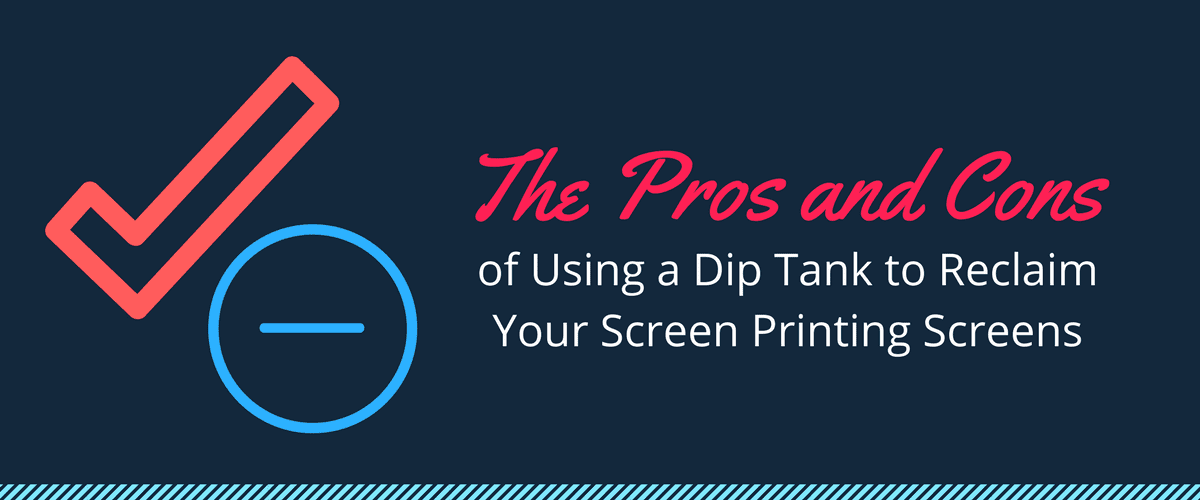In your quest for screen printing efficiency, you’ve probably considered using a dip tank to clean your screens. Is it a good decision?
So how do you decide which side is right and determine whether a dip tank is suited to your screen printing shop? As with any equipment purchase, the best way to figure out what will work for your shop is to weigh the pros and cons.
The Case for Dip Tanks
- Speed. The No. 1 reason proponents of dip tanks sing their praises is the speed of use. Place one screen in the dip tank for two to three minutes, then pressure wash it in the washout booth. When one screen is in the washout booth, the next screen can be in the dip tank. Dip tanks are deemed especially helpful for shops that are producing a large volume of prints and need to keep production rolling.
- Reduced chemical usage. Shops that rely on dip tanks claim that they see big savings on reclamation chemicals. That’s because dip tanks allow shops to use an «all-in-one» reclaiming chemical, and that cleaning solution, diluted with water, can be used in the dip tank over and over again. Some dip tank marketers say the tanks can save screen printing shops up to 75 percent in chemical usage.
- Easier stencil removal. Screen cleaning should be only a two-step process when you’re using a dip tank. The stencil is softened while soaking in an ink and stencil remover designed for the job and it can easily be sprayed away. Then, the screen is cleaned with a screen wash to remove stains. The process is easy, and the emulsion and ink should wash easily away from the screen. Just be aware that for tougher emulsions, you might also have to use a haze remover to fully clean the screen for reuse.
…and Some Drawbacks
- Consistency. Those who discourage use of the dip tank say the tanks make it impossible to control quality. While the dip tank solution begins as a perfect mix of cleaning solvent and water, as more screens are cleaned, the solution is weakened. That means that the fourth screen that comes out of the dip tank won’t be as easy to wash as the first. This can be solved, of course, by adding more cleaning solution to maintain the recommended dilution for cleaning screens, but, dip tank detractors would say, this cuts back on the chemical savings dip tank use claims to produce.
- Screen contamination. Depending on the type of screen frames you use, a dip tank could contaminate your frames and affect future printing projects. That’s because you have to put the entire frame in the dip tank, unlike the brush-on method that places the chemicals directly on the screens. Hollow metal frames or wooden frames can retain some of the cleaning chemicals, which could react with your emulsion or your ink when you move on to your next screen printing project.
- Waste disposal. The chemicals you use in your dip tank might be labeled “drain safe», but that might not be the end result. The chemical buildup within the tank, both from the cleaning solvent and the emulsion and ink that collect at the bottom of the tank during soaking, can cause chemical levels to build up to a level that defies your local disposal laws, leaving you searching for a way to safely and legally dispose of the mix. Even if the solvent in the dip tank is safe for disposal, the ink and sludge created by this disposal method can clog drains and pipes, so anyone using a dip tank must be careful to protect their drainage systems to prevent a serious plumbing problem.
As you determine what type of screen reclaiming method is right for your screen printing shop, you will come across plenty of arguments both for and against dip tanks. As with any decision it comes down to your priorities and what you feel will work best in your shop. If you need fast screen reclamation and hope to cut down on chemical usage, a dip tank might help you improve efficiency in your shop. If you’re more focused on consistency and you have the time to reclaim every screen by hand, you can opt to reclaim your screens manually. Whatever option you choose, the end result should be clean screens that are ready for your next press run.
Want some more tips on reclaiming your screen printing screens? Check out this blog post:
How to Reclaim Screens for Textile Printing




